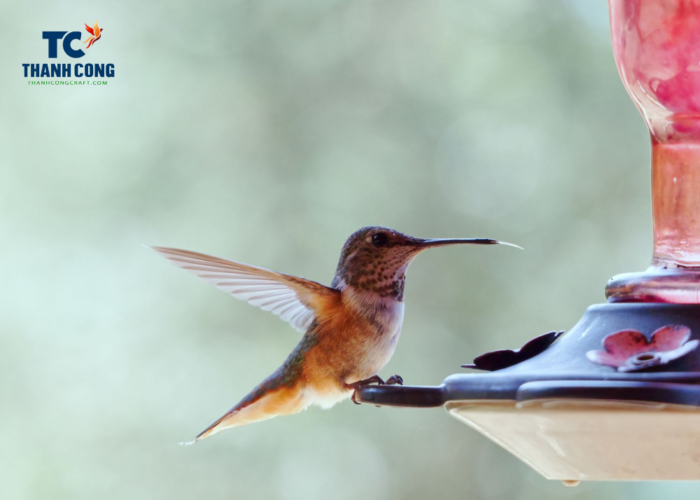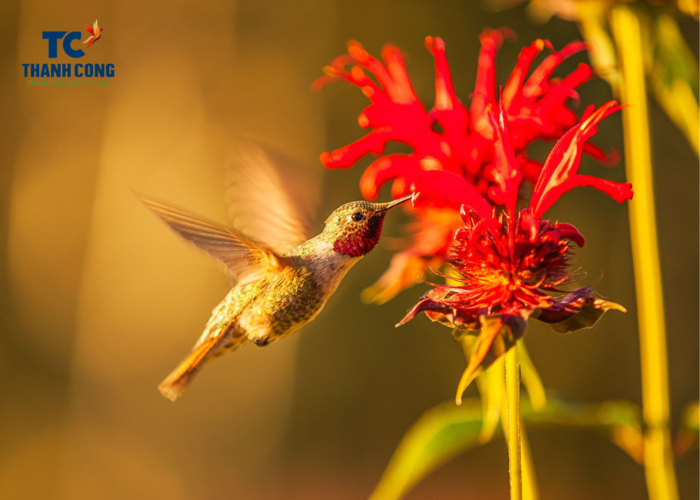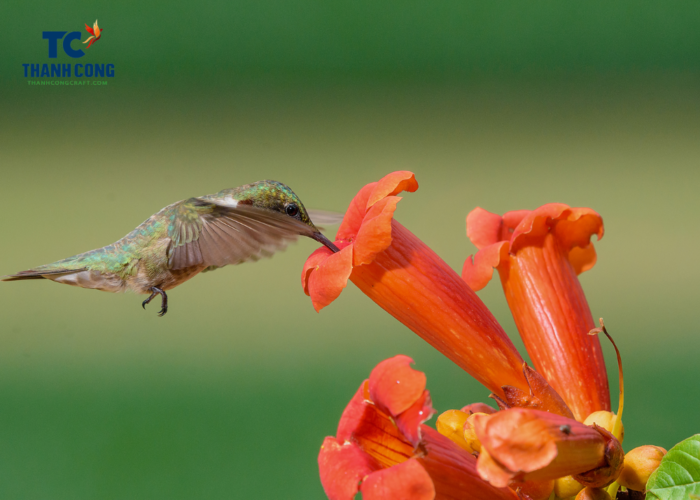If you love hummingbirds and want to attract them to your garden, yard or balcony, you need to know some simple but effective tips. Hummingbirds like places with tropical flowers, freshwater and safety. In this article, we will guide you on how to attract hummingbirds to your garden, yard, balcony.
Let’s explore how to lure hummingbirds to your garden, yard or balcony!
Contents [hide]
1. What attracts hummingbirds?
Hummingbirds are attracted to a variety of factors when seeking food, such as brightly colored flowers, nectar-rich plants, scent, tubular-shaped flowers, perches, and water fountains.
Hummingbirds are small, agile birds with the ability to fly backward. They boast vibrant colors and emit chirping sounds reminiscent of a tiny fan.
You can attract them with colorful flowers, lots of nectar, or diluted sugar water from a bird feeder. They also eat small insects to supplement their protein intake.

1.1 What colors attract hummingbirds?
Hummingbirds are strongly attracted to the red, orange and yellow. Incorporating red flowers, feeders, or even red ribbons near your garden will act as a magnet for these tiny birds. Additionally, planting brightly colored tube-shaped flowers makes it easy for hummingbirds to extract nectar. Popular flower choices include orchids, lilies, petunias, and roses.
Keeping the surrounding area clean and safe is essential to prevent hummingbirds from being disturbed by other animals. Create an environment where these delightful birds can thrive, and you’ll likely enjoy their frequent visits to your outdoor space.

1.2 What scares hummingbirds away?
Some other factors that can induce fear in hummingbirds include:
- Loud Noise: Sudden and noisy sounds, such as lawnmowers, construction activities, or barking dogs, can startle hummingbirds, causing them to avoid your garden.
- Pets: Watch out for cats, as they are predators that can scare away hummingbirds.
- Unpleasant Odors: With their keen sense of smell, hummingbirds may be deterred by strong odors, such as pesticides, strong perfumes, or paint fumes.
- Large Crowds: Continuous human activity or large gatherings can be perceived as a threat by hummingbirds, prompting them to feel uneasy and frightened.
2. How to attract hummingbirds to your yard?
Some ways to attract hummingbirds to your backyard are: Firstly, consider installing water sources such as sugar water feeders or fruit water feeders, providing these enchanting birds with convenient spots for drinking and bathing. Regularly refreshing the water is essential to maintain a clean and inviting environment while deterring unwanted insects.
Next, infuse your garden with a burst of color by planting hummingbird-friendly flowers. Opt for blossoms with vibrant hues, especially shades of red, and tube-shaped structures that cater to their nectar-sipping habits. Popular floral choices like phlox, salvia, lilies, and hibiscus can turn your backyard into a colorful and inviting oasis.

To complete the hummingbird-friendly ambiance, create sheltered spaces within your backyard. Integrate shrubs or vines to offer these delicate creatures areas for hiding and potential nesting. Ensure these spaces remain undisturbed, fostering a sense of security. Additionally, refrain from using pesticides or harmful chemicals to preserve the well-being of these graceful visitors.
By seamlessly blending these practices, you not only enhance the allure of your backyard for hummingbirds but also contribute to their overall health and sustainability in your outdoor sanctuary.
3. FAQs
3.1 How to attract hummingbirds to feeder?
Attracting hummingbirds to your feeder is a delightful endeavor that requires careful consideration and attention to their preferences. To create an enticing environment for these vibrant birds, start by selecting a feeder with bright, attractive colors, especially red, and include perches for their comfort.
Where is the best place to put a hummingbird feeder?
Choose a strategic location for the feeder, ensuring it’s visible and easily accessible while also providing some shade to prevent the nectar from spoiling in the sun. Prepare fresh nectar using a simple solution of four parts water to one part white granulated sugar, avoiding the use of food coloring.
What can I feed hummingbirds besides sugar water?
While sugar water is the primary and recommended source of nutrition for hummingbirds, you can diversify their diet with a few supplementary options. One natural alternative is to cultivate a garden with a variety of hummingbird-friendly flowers, providing them with access to natural nectar.
Regularly clean the feeder every few days, using hot water and a bottle brush to maintain a hygienic space for the hummingbirds. Surround the feeder with hummingbird-friendly flowers, creating a natural and inviting atmosphere.
3.2 How to attract hummingbirds to nest?
To attract hummingbirds to nest, you need to provide them with a suitable habitat, food sources, and nesting materials. Hummingbirds prefer areas with a variety of flowers, especially those with red or orange colors and tubular shapes.
They also need access to water, such as a birdbath, fountain, or misting device. Hummingbirds use spider webs, plant fibers, lichen, and moss to build their nests, which are usually located on thin branches or vines.
You can help them by hanging a hummingbird nesting basket filled with these materials near your feeders or flowers. Avoid using pesticides or insecticides in your garden, as they can harm the hummingbirds and their food supply.
By creating a welcoming environment for these amazing birds, you can enjoy watching them raise their young in your backyard.
3.3 How long does it take for hummingbirds to find your feeder?
Hummingbirds are attracted to feeders that provide them with nectar, a sweet liquid that mimics the flowers they normally feed on. The time it takes for hummingbirds to find your feeder depends on several factors, such as the location, the season, the availability of natural food sources, and the presence of other hummingbirds.
Generally, hummingbirds will find your feeder within a few days or weeks if you place it in a visible, sunny, and sheltered spot, and if you keep the nectar fresh and clean. However, some hummingbirds may take longer to discover your feeder, especially if they have established territories or preferences for other feeders.
You can increase the chances of attracting hummingbirds to your feeder by adding red or orange elements, such as ribbons or flowers, to catch their attention, and by planting native plants that offer them more food and shelter.
3.4 What time of day do hummingbirds come out?
Hummingbirds are most active during the day, especially in the early morning and late afternoon. They feed on nectar from flowers and insects, and they need to eat frequently to maintain their high metabolism. Hummingbirds may come out at different times depending on the season, the weather, and the availability of food sources.
However, they generally avoid flying at night or in very cold temperatures, as they can enter a state of torpor to conserve energy.
4. Conclusion
In conclusion, creating an inviting haven for hummingbirds in your garden, yard, or balcony is a rewarding and enchanting endeavor. By incorporating vibrant flowers, strategically placing feeders, and providing a comfortable environment, you can attract these delightful creatures to your outdoor space. Remember to choose the right feeder, keep the nectar fresh, and maintain a clean and safe atmosphere.
If you have any further questions, don’t hesitate to send thanhcongcraft an email us at info@thanhcongcraft.com or message us at WhatsApp: +84967485411. Hope to serve you soon! Best regard!


